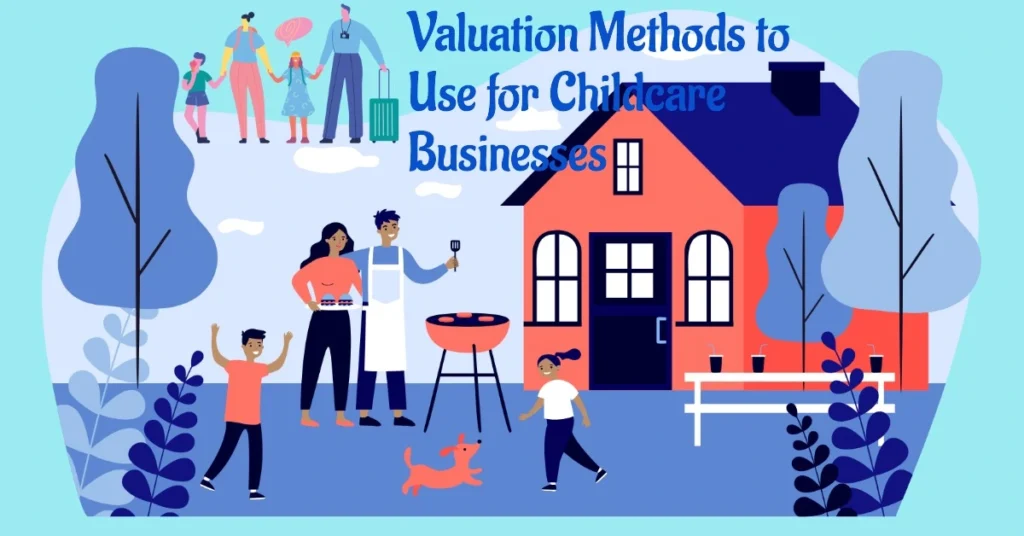Navigating the valuation of a childcare business is crucial in the competitive arena in which we operate. Discerning your venture’s precise financial health is vital if you are contemplating buying, selling, or expanding. Effectively determining the value encompasses a holistic view of current assets, earnings, and forward-looking projections.
The appropriate multiple factors in various aspects offer a rounded perspective on your establishment’s worth. This all-encompassing guide highlights the fundamental steps in appraising a childcare entity and conforming to industry norms. These protocols are essential, whether you are in the market to trade or enhance the worth of a daycare or preschool. It goes beyond mere figures, it’s about your establishment’s trajectory.
What is a Childcare Business Valuation?
A childcare business valuation is a professional estimate of the current worth and projected value of a daycare center or preschool. It determines what a buyer should fairly pay for the business or what a seller can reasonably expect to receive upon sale.

Why is it Important to Value Your Childcare Business?
Knowing your childcare business’s value is key for several reasons:
- Sets a target asking price when selling the business
- Allows you to assess purchase offers from buyers
- Helps obtain financing/investors by quantifying expected returns
- Gives insight into increasing your center’s value over time
In short, the valuation of a childcare center enables making informed decisions to maximize your childcare business’ financial potential.
Who Needs to Value a Childcare Business?
The value of the business isn’t reserved for potential sellers. Various stakeholders find this information crucial. A valuation is useful for:
- Business owner looking to sell their childcare center
- Potential buyers considering purchasing a daycare
- Existing owners seeking loans or outside investment
- Partners dividing up ownership interests
- Childcare franchises assessing expansion opportunities
Main Methods for Valuing a Childcare Business
Determining the value of a childcare center is a nuanced process, requiring consideration of various methodologies. Common valuation methods for childcare centers include:
- Market-Based Approach: Compares your business to similar childcare centers recently sold.
- Income Approach: Focuses on projected revenue, considering historical data and future projections.
- Asset-Based Approach: Totals the values of all tangible and intangible assets, offering a snapshot of current financial standing.
- Rule of Thumb: Applies industry-specific multiples, often a quick but less tailored approach.
- Discounted Cash Flow (DCF): Analyzes future discounted cash flows to estimate current business value.
Industry Overview and Market Analysis
Gaining market insights provides context for valuing your childcare business:
Industry Size and Growth
The childcare industry has expanded significantly in recent years, with an estimated 2021 revenue of over $47 billion. Analysts project the market will grow approximately 6% annually through 2028 as demand rises. This illustrates the strong potential for an existing or new childcare business.
Local Market Assessment
Research childcare centers in your geographic area, including both direct and indirect competitors. Look at their tuition rates, offerings, and capacity to gauge competition and your positioning. A desirable location with limited nearby centers can enhance value.
Factors That Affect the Value of a Childcare Business
When it comes to the childcare center valuation, certain elements weigh heavily in the balance. Recognizing these can be the key to unlocking your business’s true worth. Many factors impacting childcare beyond just financials affect your value of a daycare or the worth of a childcare center such as:
- Location: A convenient, accessible location in a family-friendly area adds value. Proximity to residential areas, schools, and commercial zones enhances attractiveness.
- Facilities and Amenities: Modern, clean facilities with security features, outdoor space, and the latest technology allow commanding higher tuition rates.
- Reputation and Customer Service: Positive word of mouth, reviews, longevity, and staff retention build trust that adds intangible value. New owners can retain existing clients through a smooth transition.
- Offerings and Curriculum: Robust programs for various age groups and even niche focus like language immersion or Montessori distinguish your center. This allows pricing premiums.
- Staff Quality: Well-trained, experienced teachers and care providers with low turnover are key for reputation and consistent offerings.
- Enrollment Rates: Full or near-full enrollment signals strong demand. Low vacancies add stability that increases value.
- Technology Integration: The use of innovative tools for education and management indicates forward-thinking leadership.
- Licensing Capacity: Higher state-licensed capacity means greater revenue potential for buyers. Expanding capacity requires investment but enables future growth.
- Financial Health: Consistent profitability, clean books, and optimized cost structure positively impact valuations and attract buyers.
Valuation Methods to Use for Childcare Businesses
The art of valuation lies in knowing which method aligns best with your business’s unique characteristics. Each approach offers different insights, contributing to a well-rounded business valuation. Now let’s explore leading valuation methods and how to apply them:

Market Approach:
This compares your center’s metrics to recent sales prices of similar childcare businesses in your area. The value of the center is based on what other buyers have historically paid including:
- Sales Comparison: Analyzing recent sales of similar centers provides a realistic market value.
- Market Conditions: Current economic trends and industry health influence buyer willingness.
- Competitor Benchmarking: Understanding where your center stands in comparison to competitors aids in accurate pricing.
- Demand-Supply Dynamics: Identifying the balance between available centers and seeking parents can dictate market value.
- Geographical Factors: Location-specific trends impact what buyers are willing to pay.
Income Approach:
This projects future cash flows and applies a discount rate to determine present value. It involves creating a discounted cash flow model based on projected profitability such as:
- Revenue Assessment: Detailed analysis of past, present, and projected revenues.
- Expense Evaluation: Understanding operational costs, including unexpected expenses.
- Profit Margins: Healthy profit margins often translate to higher business valuations.
- Financial Projections: Future income expectations based on realistic, data-driven assumptions.
- Investment Return: Potential ROI for future owners is a critical consideration.
Rules of Thumb:
Common rules of thumb calculate value based on:
- Revenue multiple – Value = Revenue x Industry Multiple
- EBITDA multiple – Value = EBITDA x Industry Multiple
- Enrollment multiple – Value = Number of Children Enrolled x Per Child Value
Childcare Industry Multiples:
Typical childcare industry valuation multiples include:
- EBITDA multiples: 5-8x
- Revenue multiples: 1-3x
- Per child value: $3,000-$7,000+
Conducting Assets and Liabilities Assessment
Understanding the financial health of your childcare center requires a deep dive into its assets and liabilities. This critical step ensures a transparent and fair valuation, reflecting the center’s true worth.
Assessing Tangible Assets:
- Property Evaluation: Whether leased or owned, the premises is a cornerstone of your business’s value.
- Equipment and Vehicles: From play apparatus to buses for field trips, physical assets add considerable value.
- Furniture and Fixtures: These everyday items contribute to the operational functionality and comfort of your center.
- Inventory on Hand: Educational materials, food supplies, and first aid essentials – every item counts.
Reviewing Intangible Assets:
- Brand Value: Recognition in the community, online presence, and reputation factor into your valuation.
- Operational Systems: Customized management systems or unique educational programs can enhance value.
- Staff Loyalty: A stable, satisfied team reduces turnover costs and adds to your business’s appeal.
- Licenses and Approvals: Compliance with all regulatory requirements assures potential buyers of a legitimate operation.
Analyzing Liabilities:
- Outstanding Loans: Existing debts can diminish the appeal of your business, affecting its overall value.
- Operational Liabilities: From unpaid bills to pending lawsuits, clear the decks for an accurate assessment.
- Future Commitments: Understand the long-term financial obligations tied to your business.
- Contingent Liabilities: Identify potential financial setbacks related to future events or uncertainties.
Building Financial Projections
Financial forecasts support an income valuation approach and help assess growth potential.
Profit and Loss Forecast:
Project your P&L statement for 3-5 years based on reasonable revenue and expense increase assumptions.
Cash Flow Projections:
Forecast cash flow incorporating profit, non-cash expenses, working capital needs, and planned capital expenditures.
Conservative projections help minimize risk for potential buyers.
Select an Appropriate Valuation Multiple
Industry-specific valuation multiples benchmarks exist for key metrics:
EBITDA Multiples:
Childcare businesses often sell for 4-6x EBITDA. Centers in high-demand markets may reach EBITDA multiples of over 8x.
Revenue Multiples:
Revenue multipliers typically range from 1-3x annual revenue depending on profit margins. Higher margins deserve higher multiples
Making Valuation Adjustments:
Certain factors may warrant valuation adjustments:
- Discount for needed investments like facility renovations or expansions
- Account for non-operating assets like excess land
- Consider risks associated with customer or revenue concentration
Sellers can negotiate fair pricing accounting for these strategic considerations.

Conclusion
Accurately valuing your childcare business enables maximizing your company’s value and financial return when exploring a potential sale or acquisition. By understanding the unique characteristics of the childcare industry, business valuation can help you objectively estimate the value of your childcare center based on its worth and profitability. It also allows you to benchmark comparable childcare centers that have recently sold in your area.
When it comes to valuing a childcare business, methodically assessing market demand for childcare services in the area is key. Following this guide and using respected industry valuation practices helps ensure your childcare center is valued appropriately. Please reach out with any other questions on valuing your unique childcare business.


3 thoughts on “How To Value a ChildCare Business – Find Out Now!”